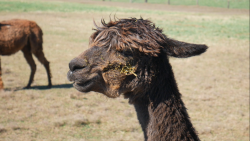One family’s move from the city to the farm has came with an abundance of yarn, laughs and alpaca spit
Birdbrain trots in the pasture with his head held high. Sometimes he’s a vanguard breaking into a gallop, and sometimes he’s a loyal follower blending in with the rest of the fuzzy herd. He may look like a guinea fowl in our human eyes, but he is convinced he’s an alpaca in his heart and soul.
The alpacas at Whistling Valley Farm are Birdbrain’s constant companions. On a bright October day, a cloak of brilliant sunshine drapes over the farm. Birdbrain basks in the sun and zips around his 28 alpaca friends in the verdant pasture.
The farm was founded by Jan Clingman, 57, and Jim Hellenbrand, 53. The pair immediately decided to buy a herd of alpacas after visiting the Great Midwest Alpaca Festival in 2009, because they fell in love with alpacas for their endearing personalities and soft fiber.
There are two breeds of alpacas, Huacaya and Suri. Clingman and Hellenbrand chose Suri, a breed with fleece hanging down like dreadlocks, who makes up less than 10 percent of the world’s alpaca population.
The farm has become a project that Clingman and Hellenbrand have worked on together with love and joy ever since. While Clingman was still working a full-time job in Madison, she relied on volunteers to help the farm with daily chores, and she visited Lodi, Wisconsin, on weekends to take care of her animals. Since her retirement in 2016, she has moved to Lodi and lives three miles away from the farm to care for the alpacas every day. It is not only a small business for Clingman’s retirement, but also her motivation to keep learning and exploring her purpose during a new phase of life.
Clingman and Hellenbrand are part of a growing movement of alpaca farmers in Wisconsin. According to the 2012 Census of Agriculture published by U.S. Department of Agriculture, there were 383 alpaca farms and 6,002 animals in Wisconsin — about a 40 percent increase since 2007.
Such a large community allows Clingman to meet new people who she might not have encountered previously in her daily life. Every day, she is amazed by the diverse populations presented in the alpaca industry, from farmers to doctors, and even Hollywood actors.
It’s all about teamwork
Clingman and Hellenbrand make a solid team. Their backgrounds and expertise allow them to divide the work and devote their energy to different areas.
Growing up on a farm, Hellenbrand raised steers with his father, and later grew crops on his own. This previous farm experience made him excel at herd management and animal care. His daily schedule has a rhythm: feed the animals, clean up after them, check their physical health and let the animals romp through the pasture with Birdbrain.
Raising alpacas is much easier than working with other large livestock, Hellenbrand says. They graze pasture in summer and eat hay in the winter, with some grain as supplements. Alpacas are also gentler in many ways because they don’t pull grass up from the roots, and they aren’t destructive to fencing and equipment. Cleaning up is easier too: They rarely dirty their stalls, but instead go outside where their community dung pile is.
“They are relaxing, low-key and enjoyable livestock,” Hellenbrand says.
Each alpaca’s unique personality makes farm life relaxing and enjoyable.
As a retiree from an information technology career in Madison, Clingman focuses on the business side and technical aspects of the farm. She manages the farm store, both online and in person, along with the bits and pieces involved in producing such alpaca products as yarn. Every day, she updates the online store and provides customer service to people across the globe.
Clingman and Hellenbrand find that sometimes collaboration is necessary — and appreciated. They accomplish difficult tasks together, such as administering vaccinations and vitamins to the alpacas or deworming them each month.
Working as a team also means sharing laughs during clumsy and embarrassing moments. For example, during scheduled breeding, when a female alpaca is pregnant, Clingman and Hellenbrand will have to separate her from the male. Otherwise, she will spit at the male alpacas and reject a male’s advances by running away and kicking him around the breeding pen.
“Jim was watching me [try to separate the male and the female] one day, and he goes, ‘Just grab him, just grab the male!’’’ It sounded easy enough, so she simply followed his instructions.
“Then I got ptttttui — spit at right at the side of my face and neck … with the stinky, green, fermented forage,” Clingman says, getting louder as she tells the story and drawing out her voice with laughter, “and he is la—ugh—ing.”

According to the Alpaca Owners Association Inc., spitting at one another is an alpaca’s way of expressing annoyance — whether they’re fighting about food or having an argument. Occasionally, they deliberately spit at people, especially when humans, in this case Clingman, get caught in their crossfire.
The fiber is the new silk
Herd management may not be new for Hellenbrand, but Clingman says digging into the technical aspects of alpacas from breeding to fiber production, is “quite a learning experience.”
Because alpacas are raised primarily for their fibers in the United States, Clingman and many other alpaca farmers need to tackle the challenge of how to run an effective fiber production process.
The first step is collection. Every May, Clingman hires professional shearers who do a high-quality clip to take the heavy layer off her beloved animals, so they can enjoy the precious summer sunshine in Wisconsin without getting overheated.
The fiber taken from the animals isn’t simply thrown into a big package. Instead, Clingman collects and packages the fiber according to its categories. The Great Lakes Alpaca Association and Clingman categorize alpaca fiber into three grades. The prime, also called the blanket, is fiber clipped from the alpaca’s back and sides. Fiber around neck area is the second, which is often shorter and coarser than the blanket. The third is the fiber from the legs, belly and chest area. Based on these categories, Clingman sorts the fiber and labels the package with the name of each animal, the shearing time, fiber categories and other details.
The detailed information that goes into the label represents a meticulous process of fiber sorting. The Alpaca Owners Association Inc. states that alpaca fiber can be sorted by as many as 16 official colors including white, beige and shades of fawn, brown, black and grey. Their fiber is vogue by nature. It is also classified by length, softness, weight and fineness — ranging from fine to medium to coarse.
It takes organization and knowledge for Clingman to correctly sort and label the fiber she collects from her animals. Some farmers are not as well-informed.
“There are a lot of breeders out there that still don’t know what to do with their fiber,” Clingman says. “They’ve got bags of their fiber in their attics, their garages, their basement and their bedrooms.”

Then comes the mills
Once the fiber is sorted and packaged, a mill must be found to process the alpaca fleece. Many commercial mills require at least 500 pounds of fiber from one grade to process it, Clingman explains. But her 28 alpacas only produce roughly 180 pounds every year.
Fortunately, Clingman found a niche — mini-mills that are willing to process smaller quantities of alpaca fiber. Customized services provided by mini-mills mean more attention to detail. The products will be labeled with the name of the particular alpaca they are made from.
“So we can have yarns made that will have a label on it that says this is Twister, and this is his yarn,” Clingman says. Many consumers care about where their products come from and enjoy making a personal connection with the animals.
What should we make?
After finding the mills to collaborate with, Clingman chooses the types of products to produce. Generally, she uses fiber that is ranked in the first and second grade to make yarn or apparel that people can wear, then turns the third grade fiber into rugs, carpeting, quilts or chair covers. When Clingman has fine fiber, she enters it into a fleece show.
“All of the fiber on the animals does get used,” she says proudly. “That’s an annual harvest.”
Turning fiber into commercial products is the farm’s major source of revenue to offset the cost of raising the animals. Clingman and Hellenbrand have a small store on their farm selling various alpaca products. It ranges from selling apparel such as alpaca socks, gloves, hats and scarves, to rugs, blankets and toys. They also take their products to sell at different festivals and events, such as farmers’ markets or wine walks.
Clingman also manages an online store that serves customers from all over the world, from Belgium to Canada. She is proud that people are discovering alpaca products. Currently, she is working to expand the online store to Shopify, an e-commerce website, to offer more natural resources and fair trade items beyond alpaca.
Figuring it all out
It takes time, devoted learning and experience to become proficient in various aspects of fiber production. Clingman was able to conquer these challenges by taking classes, participating in seminars, researching resources online and working with other farmers. She is taking a textile weaving class to turn yarn made from her alpacas into something special.
Clingman enjoys the learning process on her own. She also likes sharing information with other farmers and informing her consumers about different aspects of alpacas.
As a former urbanite, Clingman is enjoying her new experience being a farmer.
“It’s more relaxing — much more relaxing — than in the business world,” Clingman says. “The alpaca won’t care if you’re an hour late to feed them, and [you] don’t have to punch a clock with them. They are just happy to see you, no matter when you come.”

Krystal is a senior double majoring in journalism with a focus in strategic communication and radio, TV & film, with a certificate in digital studies. If you spot a girl zipping around campus, camouflaged among bags of camera, tripod and other equipment that are almost her height — it’s probably her! She is always on the way to produce videos for Curb, The Badger Herald, RecSports and other local businesses and nonprofits.
When she is not busy nitpicking every frame while editing footage on Premiere Pro 24/7, you can find her being a big foodie and trying new restaurants. As a soon-to-be December graduate, she is looking for opportunities in video production, advertising and nonprofit communications.


 Published Dec. 5, 2017 //
Published Dec. 5, 2017 // 